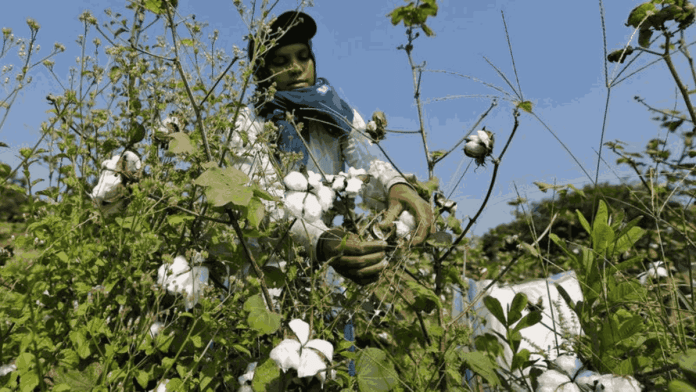Gurugram: After recording a two-decade low in the yield of cotton last year due to pest attacks and climatic conditions, Haryana has this year registered the lowest yield in the north region. This is largely because of widespread attacks of pink bollworm and boll rot on the crops, impacting not just the output but also the quality.
The poor quality has also meant that farm labourers are reluctant to pick the cotton, and are charging much higher rates. Farmers, thus, are barely earning anything from their produce.
According to the estimates of cotton production for the year 2023-24 released this week by the Cotton Association of India (CAI), a representative body which provides services to the cotton value chain since 1921, Haryana recorded a yield of 352.02-kg lint per hectare against 475.80 kg in Punjab and 603.92 kg in Rajasthan.
The average yield of the north region comprising the above three states was pegged at 487.51 kg and that of the nation at 428.65 kg lint per hectare, according to the CAI estimates. The details are available on the CAI website.
Meanwhile, cotton farmers in Haryana maintain that the situation on the ground is even worse. Gurdial Mehta, a progressive farmer from Panjuana village of Sirsa, said he could get 3 to 4 quintals per acre crop against 10 to 11 quintals two years back, due to a pest attack.
Speaking to The Print Thursday, Mehta said that the crop will be hardly enough to recover the input costs.
Om Prakash Garwa, a farmer from Mehna Khera of Rania tehsil in Sirsa district said that against picking 10 quintals of raw cotton per acre of land in the 2021-22 season (the production was very poor last year too), he has been able to get 2 to 2.5 quintals of the crop per acre this year. But there are no takers for it because of poor fibre quality.
“Growing cotton crop this year has proved to be a bad bargain to us this year as well. I sprinkled 13 rounds of pesticides and still the crop was badly damaged because of the twin infections of pink bollworm and boll rot. The little crop I got after paying higher rates to labourers for harvesting is of poor fibre quality and hence isn’t saleable in the market,” Garwa said to ThePrint Thursday.
Haryana Agriculture Minister J.P. Dalal, who visited cotton fields in Bhiwani district in October for first-hand knowledge of the damage, told ThePrint, “The state government is abreast of the situation. The pink bollworm and fungal attack have done immense damage to the farmers’ crops in the state this year. However, the state government will compensate the farmers suitably.”
High labour charges
Garwa said labourers normally charged Rs 7 to 8 per kg of the cotton plucked from the bolls. But since the content per boll is poor this time, they are demanding Rs 18 to 20 per kg.
“Many farmers in my neighbouring village Chilkani Dhab are yet to harvest their crop because labourers are not ready to take up the job,” he said.
Gurpreet Singh Nagpal, a partner in the Royal Cotgin, a cotton ginning unit at Sirsa, echoed Garwa’s concerns about the quality of fibre this year.
“Because of the poor quality of fibre, we are getting Rs 5,400 per maund (a unit of weight prevalent during the British Raj and equivalent to 37.32 kg) this year against Rs 6,600 last year. Similarly, the rate of raw cotton hovered between Rs 5,000 and Rs 7,200 per quintal, depending on the quality this year. Though the rate was around Rs 7,200 last year too, the variation of more than 20 percent in the procurement price this year is huge,” Nagpal said to ThePrint.
Two-fold damage
Pink bollworms are pests which chew through the cotton lint to feed on the seeds. Since cotton is used for both fiber and seed oil, the damage is thus two-fold. Their disruption of the protective tissue around the boll is a portal of entry for other insects and fungi.
On the other hand, boll rot is a fungal infection that rots the lint as well as the seeds.
Dilip Monga, a former head of the Central Institute for Cotton Research (CICR) of the Indian Council of Agriculture Research, said he has found that crops in Haryana have been the worst affected because of the attack of pink bollworm and boll rot.
“As far as Punjab is concerned, its area under cotton has been continuously reducing primarily because more farmers are moving towards paddy because of free power by the government in that state. On the other hand, Rajasthan has increased its area over the years and now, cotton is sown in the central and southern districts of the state too while earlier the crop was largely in the northern districts of Ganganagar and Hanumangarh. While the northern districts of Rajasthan are in continuity with cotton-producing areas of Haryana and Punjab, others are far away and unaffected by the pink bollworm and boll rot,” Monga said.
According to the information on the CAI website, while Punjab’s area under cotton has come down to 1.69 lakh hectare this year from 2.91 lakh hectares in 2017-18, it has increased in Rajasthan to 7.91 lakh hectare from 5.84 lakh hectares during the same period.
(Edited by Smriti Sinha)
Also read: Big push for Ahir regiment in Army coming to Delhi’s Ramlila ground. ‘Plan to fight decisive battle’






